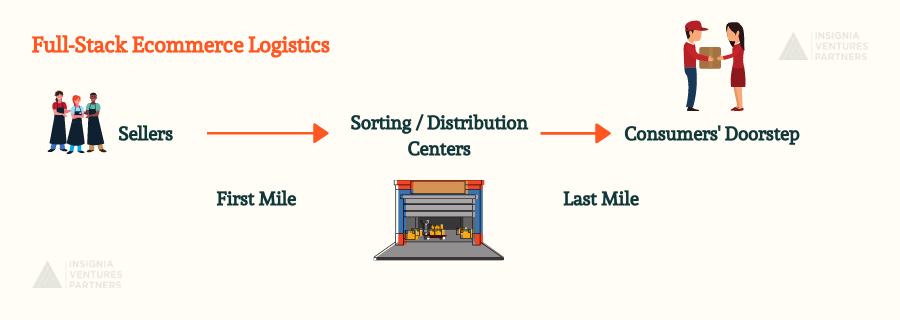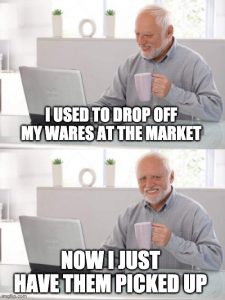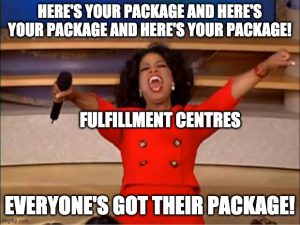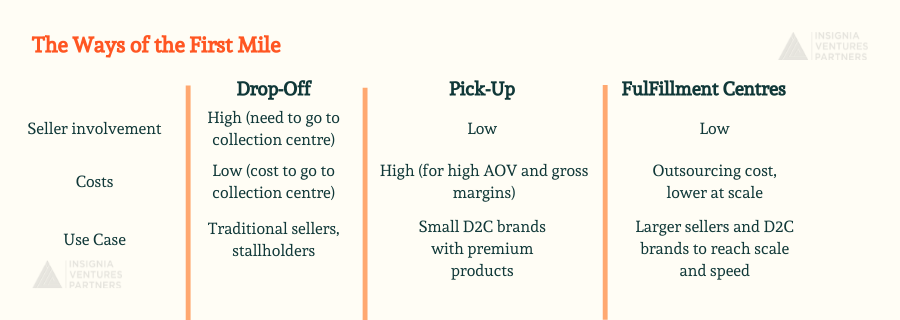Highlights
- While we have made the journey from sorting or distribution centre to doorsteps efficient (last mile), there is a real bottleneck on the first mile where sellers drop their packages onto the network. The pushback to developing the first mile logistics has been two-fold: it is incredibly complex and customer demands were diverting attention to improving the last mile. But as consumers demand quicker delivery, the need for a more efficient ecommerce logistics chain spanning end-to-end becomes more apparent.
- Three options to get your goods onto the logistics chain:
- The Drop-Off: Traditional method of using collection centres / postal system
- The Pick-Up: Pay a premium to have goods picked up by logistics provider
- The Fulfillment Centre: Outsource first-mile needs to logistics provider that can meet demands of scale and speed with storage areas (fulfillment centres, warehouses) and strong network
On yet another work-from-home day filled with endless Zoom calls, the doorbell rings. As a VC, I love going out to meet people, a luxury I do not have working from home. As I leap out of my seat in joy for some long-awaited seconds of human interaction, I play a little game in my mind called “Which last-mile courier is it today?”
Last-mile or “outbound” logistics refers to the home stretch that products take to become finally delivered to consumers. This has been the buzzword of the ecommerce logistics industry in the past 3 to 5 years in Southeast Asia and is fairly developed. In most areas, the last-mile is fast and efficient with high visibility. It has developed and adopted dedicated technologies with real-time tracking, supported by a network of IoT and mobile devices with dedicated customer service and cost control.
In our region today, the last mile has become an increasingly crowded space with so many household names from J&T to Ninjavan, making my little game of “Guess the courier” possible. Despite these huge advances in the last-mile, the development of ecommerce logistics ecosystem in the region is far from being full stack. Where a developed outbound logistics system has made ecommerce logistics possible at a functioning basic level, Southeast Asian consumers are now raising the bar, demanding for a better ecommerce experience. We want shipping to be free, and delivery to be next-day (or even same day)!
What is the First Mile and why are we not talking about it as much?
With the last mile becoming a highly-developed space, we turn our attention to the first mile or “inbound” logistics, the part of the value chain where goods enter the logistics system and begin their long journey to the consumer. In our region, first-mile logistics is still largely unoptimised. It is inefficient, expensive, and opaque. While we have made the journey from sorting or distribution centre to doorsteps efficient, there is a real bottleneck on the first mile where sellers drop their packages onto the network. It is still reliant on spreadsheets and paper forms, with most sellers having to drop their packages off at their nearest post office or outbound centre.
The pushback to developing the first mile has been two-fold: it is incredibly complex and customer demands were diverting attention to improving the last mile. Replacing drop-off centres which essentially operate as post offices, a model that has existed since the beginning of time, involves developing new technologies and large expenditures. Fortunately, as consumers demand quicker delivery, the need for a more efficient ecommerce logistics chain spanning end-to-end becomes more apparent. We also see that standard last-mile technologies such as IoT devices and route optimisation technology are becoming more applicable and adopted in the first mile. This end-to-end integration and standardisation across the supply chain is becoming a serious operational consideration.
The Three Ways of the First Mile
As a seller, ensuring a smooth first-mile delivery is crucial to minimising the bottleneck in a parcel’s journey, ensuring it smoothly enters the supply chain and flows through in an unhindered manner. In entering this logistics system, you have three options to get your goods onto the logistics chain. Drop-offs have been the most traditional and common first-mile solution, which pick-ups soon evolved from. Lastly, fulfilment centres have allowed sellers to outsource the first mile altogether.
The Drop-Off: The Old Path
Drop-offs have been the traditional first-mile solution, where merchants are responsible for transporting their goods to collection centres and drop-off points. This is based on the age-old postal system, where individuals would have to go to their nearest post office to send out a package. In fact, we have seen many cases in Southeast Asia where national postal systems are still being used to send ecommerce parcels, as they remain the only first-mile solution in their area. With the lack of specialised first-mile players in smaller cities and towns, this seems to be the only viable option for many online sellers.
Nonetheless, we are seeing more specialised first-mile logistics providers enter the space and begin to operate their own collection centres, usually situated near flea markets and warehouses. To understand this, we must trace the origins of independent ecommerce retailers in Southeast Asia, especially in Vietnam and Indonesia. Many of these sellers began as, and still are, stallholders at flea markets. Having onboarded onto popular ecommerce platforms, they sell anything from footwear, phone cases, even knock-off luxury goods. Sellers close to these collection centres can tap on their cheap and fast-moving outbound logistics system, quickly sending these packages onto the network. But what if you’re not close to a drop-off point, or have too many parcels? You can get it picked up!
The Pick-Up: Premium to Focus on the Business
While first-mile logistics providers have begun operating their own collection and sorting centres to serve the rising number of internet sellers, they have also begun to offer pick-ups as a value-added service. Though these pickups may incur additional costs for sellers, we see them commonly used by D2C consumer brands, who have higher order values and thus gross margins. These consumer brands have the bulk and margin to pay for quick first-mile pickups to guarantee next-day (or even same-day) delivery, with the consideration that it improves the overall customer experience. Sellers could have packages collected by these providers at their own shop fronts or facilities, to save them time and extra effort, allowing them to focus more on the business.
With many of these first mile players, we have also seen 4PL players like Janio to help brands gain end-to-end visibility on their supply chain. Janio can help compare the different first-mile players (and all the way up to the last mile) and put together different pieces of the puzzle to optimise the route taken by a parcel. Where the first mile pales in comparison to the development of last mile logistics, Janio can help reduce this symmetry and get parcels quicker and on time.
The Fulfilment Centre: Outsourcing Scale and Speed
At larger volumes, having constant pickups and dropoffs would prove to be highly inefficient, sellers cannot afford to pack and send their parcels off one-by-one, so they outsource this to fulfilment centres. Amazon has popularised the fulfilment centre when they launched their same-day Prime model. The world was in awe: as if being able to buy goods and have them delivered on our doorsteps was not enough, we can now have it on the same day, made possible by Amazon’s high tech fulfilment centres, which heavily leverages on robotics to efficiently pick for items and assemble orders, pack them into parcels, and even restock shelves.
In Southeast Asia, brands have greater access to (and greater need for) fulfilment centres, where they can simply drop off their products, or arrange them to be shipped there to await orders. Connected to their online ecommerce shop front, a picking and packing request would be sent straight to the fulfilment centre, which will send the package on its journey. The ecommerce seller can then simply focus on providing better customer service and using their feedback to make better products. Players in Southeast Asia enabling sellers to have this “Amazon-style logistics” include Shipper with its network of micro-fulfillment centres and warehouses brought together through partnerships with logistics players, local community agents. The need for these fulfillment centres ties into the reality that countries in Southeast Asia like Indonesia and the Philippines are geographically fragmented, making it difficult for sellers to meet scale and speed on their own.
Tapping into the First Mile
Ecommerce logistics in Southeast Asia is truly changing, and sellers no longer have to drop parcels off at their nearest post office or collection centres. The stark asymmetrical contrast between the first and last mile is slowly fading away, making the whole end-to-end experience much smoother. With the removal of the bottleneck in the first mile, we will be able to see same day deliveries, perhaps even for cross-border ecommerce.
Russell is excited about the power of innovation improving lives across Southeast Asia. An ex-founder from the London McKinsey Venture Academy, Russell is now looking for daring new founders in Southeast Asia. Drop your pitch at russell@insignia.vc.



